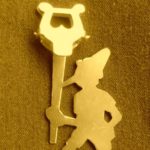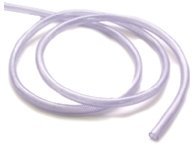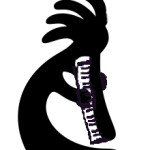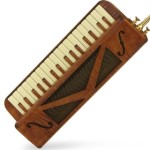Mouthpieces & Tubes
Tagged: mouthpiece, tube
- This topic has 19 replies, 7 voices, and was last updated 9 years, 11 months ago by
 Steven Morris.
Steven Morris.
-
AuthorPosts
-
November 21, 2013 at 10:16 pm #960
 Alan BrintonParticipant
Alan BrintonParticipantI’m curious about other people’s preferences and experience with different kinds of mouthpieces. There’s a lot to be said for blowing directly into the end of the melodica, in particular the feeling of vibration on your mouth. But among mouthpieces, I am partial to the curved one used on Yamaha pianicas. (Hohners have a similar looking mouthpiece, by it is not so smoothly crafted.) Unfortunately, the Yamaha mouthpiece does not fit my other melodicas. The advantage of the mouthpiece over just blowing directly into the thing is that it removes my head just far enough to provide a bit of peripheral vision of the keyboard.
With the Hammond 44 (acoustic model), I’m most comfortable using a guitar strap and the goose neck mouthpiece.
Tubes: The Yamaha tubes are not as flexible as others; I think they are unacceptably inflexible and use a Suzuki tube instead. The fittings are different, but the tubes are interchangeable. But I seldom use a tube. Out of curiosity, though, I have experimented with some alternatives. I went to Ace hardware with fittings, explained what I was up to, and bought lengths of various kinds of tubing. The only tubing worth a darn for this purpose turned out to be latex rubber surgical tubing. 1/4″ was all my hardware store had, and it will stretch to fit, but eventually, after failing to find 5/8″ on Amazon, I found it by searching the Internet. It is highly flexible and has some advantages over regular melodica tubing, though it has two disadvantages: (1) It can accidentally fold over while you’re playing and cut off the air supply; (2) Moisture can accumulate in it to the point of gurgling. On the other hand, you can fiddle with the tube, squashing, pinching, etc. to produce some unusual effects. Scuba shops and outlets and medical supply outlets have latex tubing.
November 22, 2013 at 5:07 pm #967 DarenKeymaster
DarenKeymasterI’m also keen on the Yamaha mouthpiece. It’s really comfortable. When playing a Hammond 44, I use the Suzuki mouthpiece from an M37, as I really don’t like those long pieces it comes with. I don’t use tubes at all, though I have experimented with clear flexible plastic tubing from a hardware shop before. That did work really well

The Hammond gooseneck seems to be a good rugged solution. A longer one would be even better!
November 23, 2013 at 9:17 pm #976 KevinParticipant
KevinParticipantI used to always use mouthpieces but after seeing some videos of “famous” players using the tube I use it almost exclusively. One thing I do different is I don’t use the mouthpiece on the end of the tube. My first melodica didn’t have a mouthpiece on the tube end and I feel like I am getting more air into the instrument.
I’m a visual player so I like being able to have full view of the keyboard, feel free to hold the instrument in different positions if my hand is tired and I don’t feel like I’m going to pry my teeth loose.
I’ve read where people have said they thought the melodica sounds better with the mouthpiece or blowing directly into it? However I think part of this could be due to proximity of the instrument to your ears? I’ve tried playing with the mouthpiece then playing with the tube but holding the melodica the same distance from my mouth and I can’t hear a difference.November 24, 2013 at 8:01 pm #982 QuetscherParticipant
QuetscherParticipantHi Alan,
my melodica “career” began with a Hohner Piano 36 containing two mouthpieces which you can see here:
http://www.hohner-cshop.de/Melodica/Piano-36/Mundstueck-Piano-36-HOHNER.html
As soon as I had learned how to blow properly into the trumpet mouthpiece, I never again wanted to use any other mouthpeace because it enables you to create sounds never before heard.
At the moment I’m keen on using other mouthpieces such as a bassoon or clarinet mouthpiece to produce other unusual sounds. Has any of you ever tried anything like that?
Andy
November 24, 2013 at 9:56 pm #983 Alan BrintonParticipant
Alan BrintonParticipantHi, Andy. I’m very much interested in your comments. I had never played a wind instrument (mostly just bad piano) until I took up the melodica about two years ago. A trumpet mouthpiece was supposed to come with one of the melodicas I ordered from Melodicas.com. It didn’t and they were unresponsive, so I finally bought one on eBay. However, since making a few feeble efforts with it, I haven’t done anything more with it. I really don’t understand much about mouthpieces of other instruments, but I’m all for experimentation. Do you blow into the melodica mouthpiece in the same way you’d blow into a trumpet?
November 25, 2013 at 10:56 am #987 QuetscherParticipant
QuetscherParticipantHey Alan,
yeah, it’s like blowing into a trumpet. If you need instructions, there are some good YouTube videos on how to blow into a trumpet mouthpiece.
But be aware that you don’t produce a proper second note by doing that, it’s just like adding noise to the tone of your melodica, like making it sound dirtier.
By the way: I tried doing this with and without the cap at the bottom to release the moisture, and I found it way easier without (but probably that works only for the Hohner Piano 36).
Greetings, AndyNovember 27, 2013 at 9:47 pm #995 DarenKeymaster
DarenKeymasterHi Andy, this is really interesting. I was chatting to an accordion player who also plays brass instruments the other day, and he was explaining all the possibilities. Have you made any recordings or videos?
November 29, 2013 at 2:17 pm #1028 QuetscherParticipant
QuetscherParticipantHi Troy,
you could listen to this; it’s not exactly music, but a soundscape which I recorded for a performance of Shakespeare’s “Hamlet”.
December 2, 2013 at 5:42 am #1037 KevinParticipantDecember 2, 2013 at 5:44 am #1038
KevinParticipantDecember 2, 2013 at 5:44 am #1038 KevinParticipantDecember 2, 2013 at 3:28 pm #1052
KevinParticipantDecember 2, 2013 at 3:28 pm #1052 DarenKeymaster
DarenKeymasterThanks for uploading Quetscher. It’s really interesting to hear what people are doing with melodicas, especially with extended techniques. I bet the director was really happy with that – dark, disturbing, atmospheric…
And Kevin, what an informative video! I’ve never tried that, but now I can try 🙂
December 2, 2013 at 5:55 pm #1054 QuetscherParticipant
QuetscherParticipantHonestly spoken, the director didn’t even need it. Anyway, it gave me the opportunity to refine my playing technique.
I’m glad YOU like it, also thanks for what you wrote in the “New Hohner model” forum.December 4, 2013 at 11:18 pm #1061 Alan BrintonParticipant
Alan BrintonParticipantThanks for sharing the audio, Quetscher, and the video, Troy. This is really useful for me.
January 17, 2014 at 11:11 pm #1554 LowboyParticipant
LowboyParticipantQuetscher,
Awesome performance in Hamlet. I am just getting to this thread today.
I am very interested in you exploration of clarinet and bassoon mouth pieces. Is this how you performed the Hamlet piece? It almost sounds like a clarinet or bassoon tonality.
Do you attached these mouth pieces directly to the instrument? If so, how did you do that?
What else have you done in this arena and what are thinking about it?
Inquiring minds want to know. 🙂
Regards,
Lowboy
January 18, 2014 at 1:49 pm #1556 QuetscherParticipant
QuetscherParticipantHey Lowboy,
thanks a lot; the Hamlet piece is more than five years old, so I actually used my old Hohner Piano 36 with a trumpet mouthpiece. The idea of using other mouthpieces occurred to me only a few months ago when I began to try out new ways of producing sounds on the Vibrandoneon. And yes, there are problems with attaching other mouthpieces to a melodica which I couldn’t resolve until today (honestly I didn’t try too hard because there are so many other interesting things to try out…).
During the recording session five years ago I also recorded some soundscapes consisting of keyboard sounds, some with actually playing the melodica at the same time, some without. In my opinion this is a fantastic way to add new sound aspects to melodica playing. You can even produce real good click sounds when triggering or releasing the keys or add a little breath by not closing your lips completely around the mouthpiece but letting a little air float by. So you get an airier tone.
-
AuthorPosts
- You must be logged in to reply to this topic.
